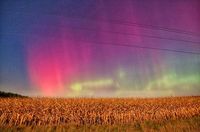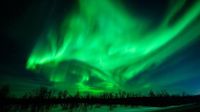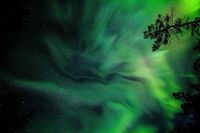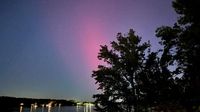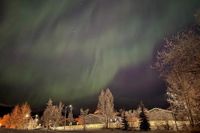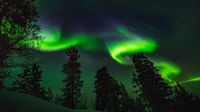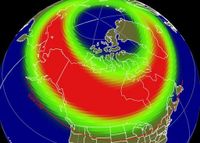Skywatchers in North America are in for a spectacular treat this week as the Northern Lights, also known as the Aurora Borealis, may be visible across several northern states and parts of Canada. The National Oceanic and Atmospheric Administration (NOAA) has issued a G3 (strong) geomagnetic storm watch for April 16, 2025, due to a recent surge of solar activity that is expected to enhance auroral displays.
The NOAA Space Weather Prediction Center announced that a coronal mass ejection (CME) from the sun, which occurred on April 13, is anticipated to reach Earth’s magnetic field, sparking geomagnetic storms that could last into April 17. These storms are caused when charged particles from the sun collide with gases in Earth’s atmosphere, creating the stunning light displays typically seen near the magnetic poles.
According to NOAA space weather forecaster Shawn Dahl, there is potential for the geomagnetic storm to escalate to G4 (severe) levels if the magnetic field of the CME aligns favorably with Earth’s own magnetic field. "By this, I mean the magnetic field of the CME needs to be opposite that of Earth's to get a good geomagnetic reaction," Dahl explained. "Think of it like opposite polarity magnets that attract."
The auroral activity is forecasted with a Kp index of five on a scale of nine for the night of April 16, suggesting that the Northern Lights could be seen further from the poles than usual. This means that states like North Dakota, Montana, Minnesota, and parts of Michigan, Wisconsin, and even as far south as New York and Oregon could have a chance to catch a glimpse of the lights.
While the best viewing conditions are expected in Canada and Alaska, where clear skies are more likely, the NOAA advises that those hoping to see the aurora should find a location away from city lights and look north during the darkest hours of the night, typically between 10 p.m. and 2 a.m. local time. For those interested in photography, using long-exposure techniques can help capture the beauty of the auroras even if the naked eye cannot see them clearly.
April is known to be a favorable month for aurora sightings as it coincides with the solar maximum, the peak of the sun's 11-year activity cycle. "During this time, we expect to see more sunspots, and therefore, there's a higher chance of high-impact space weather occurring on any given day," said Elsayed Talaat, director of the Office of Space Weather Observations at NOAA.
This week’s geomagnetic storm watch is particularly exciting, especially given that the last time the Northern Lights were visible as far south as northern Florida and Texas was during a powerful geomagnetic storm in May 2024. The current conditions are expected to be just as favorable, with the potential for auroras to be seen low on the horizon in places like Seattle, Des Moines, Chicago, Cleveland, and even Boston.
For those in Canada, the aurora forecast shows high visibility chances, especially in regions such as Ontario, Quebec, and the Atlantic provinces. Clear skies are expected to prevail in Northern Ontario, enhancing the likelihood of a spectacular display. The Canadian Space Weather Forecast Centre also predicts that auroras may be visible in locations like Inuvik, Yellowknife, and Iqaluit, as well as in southern regions of British Columbia and Alberta.
However, cloud cover could pose a challenge for many viewers. According to forecasts, areas in the Midwest and parts of the northeastern U.S. may experience overcast conditions that could hinder visibility. In such cases, NOAA recommends checking local weather reports to find the best viewing spots.
As the aurora borealis is a product of solar events interacting with Earth’s atmosphere, the colorful displays are created when electrons from solar winds collide with oxygen and nitrogen gas. This interaction produces the stunning ribbons of color that dance across the night sky. The best time to view these displays is typically during the equinoxes in March, April, September, and October, when the Earth’s position relative to the sun is ideal for geomagnetic storms.
For those who are eager to witness this natural phenomenon, it’s crucial to stay updated on the NOAA's 30-minute Aurora Forecast, which provides real-time visibility updates and can help enthusiasts plan their viewing experiences. Whether you’re an experienced stargazer or a first-time viewer, this week’s aurora borealis is worth staying up for. Just remember to bundle up, find a dark spot away from city lights, and enjoy the celestial show!
In summary, the Northern Lights are set to dazzle observers across parts of the U.S. and Canada this week, thanks to a strong geomagnetic storm triggered by solar activity. With favorable conditions expected, skywatchers are encouraged to take advantage of this rare opportunity to witness one of nature's most breathtaking displays.
